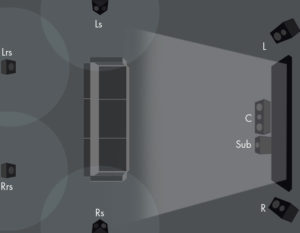
Use the Up and Down / but- tons to select “SurrBack Sp Spacing”, and use the Left and Right [
Thx audio setup plus#
SurrBack Sp Spacing THX Subwoofer BGC Loudness Plus These settings are not set automatically by the Auto- matic Speaker Setup function (see page 64). When “Loudness Plus” is set to “Off”, the “Preserve THX settings” can be selected. Use the Up and Down / but- tons to select “6. Use the Up and Down / but- tons to select “2. If the main menu doesn’t appear, make sure the appropriate external input is selected on your TV. Press the REMOTE MODE button, followed by the button. This result is only available when the THX listening mode is selected. When the “Loudness Plus” is set to “On”, it is possible to enjoy even subtle nuances of audio expres- sion at low volume. You can also set the THX Loudness Plus feature “On” or “Off”. You can then apply THX’s Boundary Gain Compensation (BGC) to compensate the perceived exaggeration of low frequencies for listeners sitting very close to a room boundary (i.e., wall).

If you’re using a THX-certified subwoofer, set the “THX Subwoofer” setting to “Yes”. This setting is used by Speakers A and Speakers B. THX speakers also offer good dispersion patterns, and are certified to have an accurate frequency response up at 15 and 30 degrees off-axis.With the “SurrBack Sp Spacing” setting, you can specify the distance between your surround back speakers. That’s not because they have the THX logo rather it’s because THX certified speakers have actually been tested and built to have a pretty flat frequency response, at least in what’s known as the “critical band” (200Hz to 6KHz.) Of course, the frequency response is pretty darned flat below and above 6KHz, too. The Definitive Technologies powered towers have served me well, but the idea of THX certified speakers, like Atlantic Technologies 4200e series, has become appealing. Of course, this all leaves me wanting new speakers. Read Loyd’s latest journey on Setting Up a Home Theater. One of THX’s guiding principles is “ every seat a good seat.” The goal here is not to create a hard-core audiophile system with a single sweet spot, but to create a sonic field that can envelope the entire audience, albeit a small one. More importantly, I’ll be sitting in the other seats as further tweaks happen. Then I piped the LFE signal from the Gold Line DVD, which generated a signal through the subwoofer, and level-matched that output to 75dB, using the level adjustment knob on the subwoofer. I then cranked up the receiver’s volume control until the SPL meter-which was set roughly at ear level of the primary listening spot-read 75dB (C-weighted.) The Gold Line DVD was ideal for this, so I used the center channel wide spectrum, 0dB reference level pink noise signal.

One way to do this is to pipe a broadband pink noise signal through one speaker. Ideally, you want to match the subwoofer output to that of the other speakers in the room.

After attending the THX class, I realized I was setting the levels of the subwoofers incorrectly. However, after running Audyssey’s calibration routines for the three primary seating positions in the family room, I came away vaguely unsatisfied with the result. I ran the Audyssey calibration before I headed off to THX training, using the seating positions indicated in the earlier Family Room chart. While I’d love to drop a few thousand dollars on a real-time analyzer, sound generator, and oscilloscope, I can’t justify doing that just for my one room. Again, not all of us can afford the same pricey set of measurement and calibration tools that professionals use. To do this, you need a proper set of tools. The only real answer is to try to measure what’s going on. Also, the presence of a glass patio door on one side and a permanent opening on the rear right (where stairs go up to the living area) mitigate the room modes considerably-although that opening introduces other complexities, such as making the room seem acoustically larger than it really is. That’s because my family room is a real room, with openings, furniture, and other “clutter.”ĭescribing my family room as “cluttered” is probably an understatement. In fact, when I measured the bass output with a sound pressure level meter using test tones, the bass levels varied about 3-6dB in various parts of the room-certainly not 40dB or even the 20dB a non-square room might have.

The potential problem of a 40dB bass drop at the center of my square room is only true for a sealed room, with relatively little clutter in the room.


 0 kommentar(er)
0 kommentar(er)
